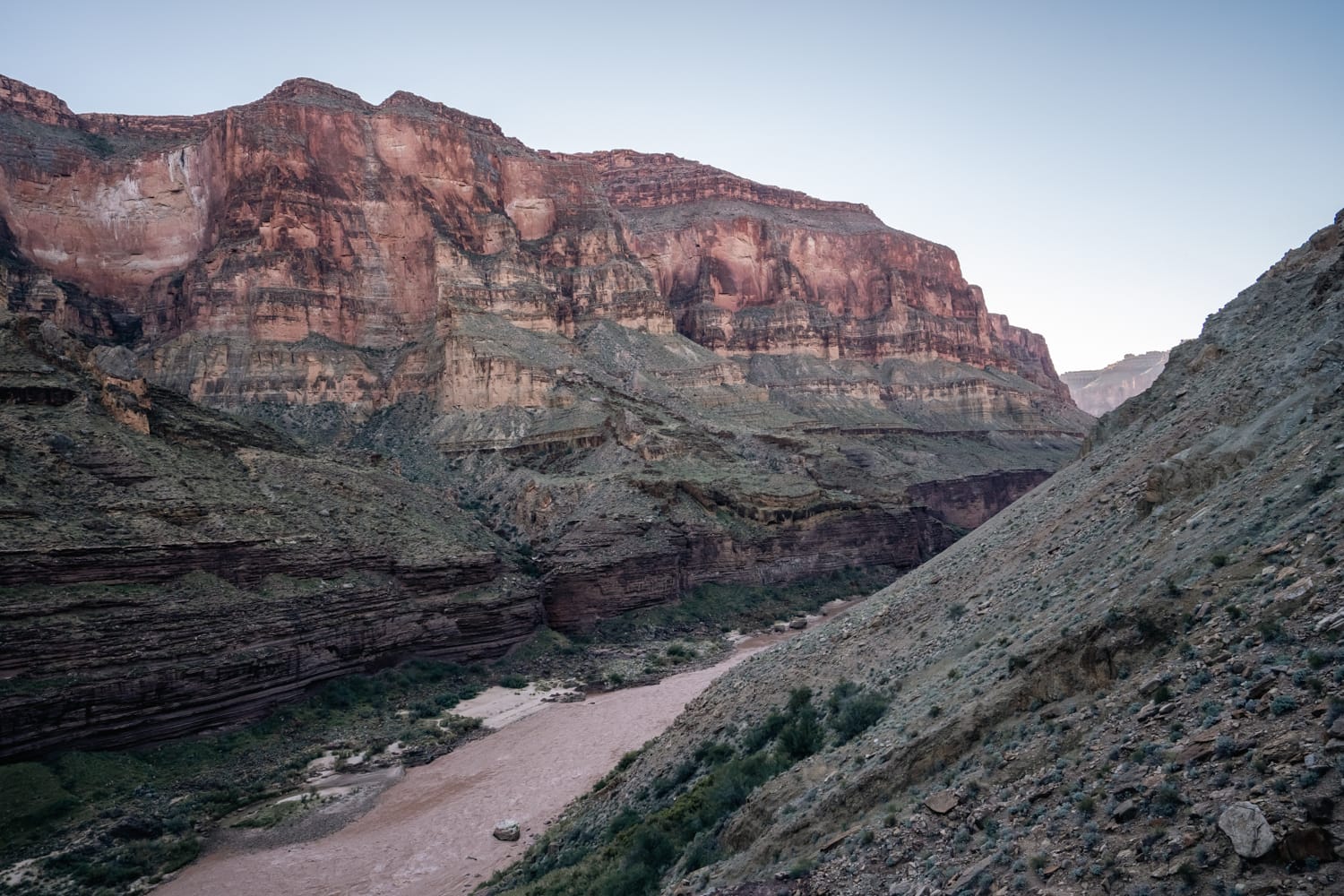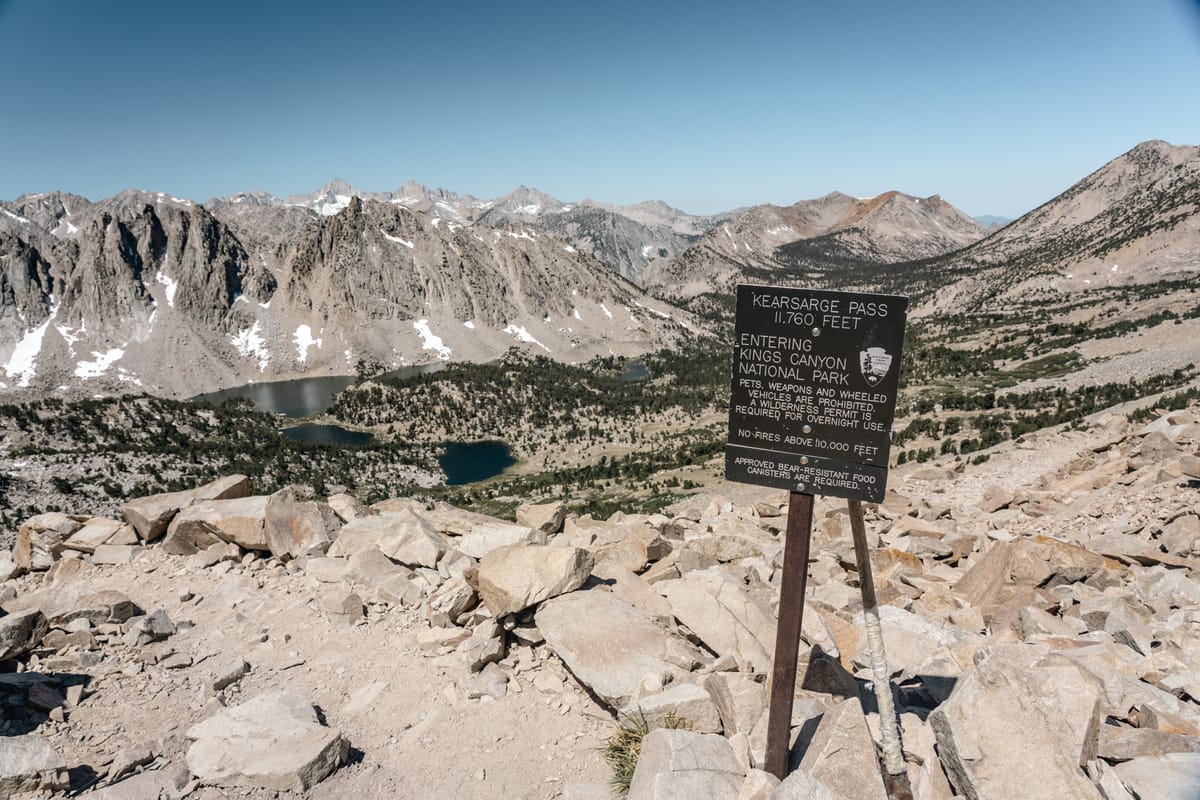Oh. I see it now.
On a trail above treeline, somewhere upwards of 10,000 feet, my gaze is fixed east toward where I came from. It's June 2022, and I'm midway through my standard summer vacation activity: schlepping myself, my camera, and a bucketload of snacks up the side of a mountain. Breathless and slightly wheezing as I aim for higher climes, it's my first real alpine outing of the summer.
I'm standing on and staring back down at the place where the land transforms itself between California's coastal Mediterranean climate and the arid Southwest. Political borders be damned, I was struck by the actual, practical transition between ecosystems.
This particular trail slices its way up the eastern slope of the Sierra Nevada range, crossing over Kearsarge Pass into a basin checkerboarded with alpine lakes all the way to the horizon line. On this quiet weekday, I mostly cross paths with sun-baked, heavy-laden thru hikers headed down for a resupply.
Thanks to a quirk of the local plate tectonics umpteen million years ago, the eastern slope is precipitous and unforgiving. No gentle rise, just a craggy, ominous drop from the Sierra crest straight down to the dry side of the rain shadow. I look out toward the deep basin of the Mojave Desert, lined through with ribbons of lesser-known mountain ranges and foothills, eventually rising up to the vast Colorado Plateau well beyond my sight line.
In my mental map of the American West, the Sierra and the Southwest suddenly and plainly knit themselves together, a cohesive whole where once I'd conceptualized the two as islands, experienced separately rather than in direct relation to one another.
On the climb up the pass, I stood at the confluence of the two worlds I loved most.
The first time I visited the Sierra Nevada, I was reduced to tears from its majestic beauty.
The first time I saw the Southwest, I could only think of how desolate it was.
I fell in love with the Sierra effortlessly. Something about it felt warm, accessible, welcoming–a softer wilderness, easy to love. After my first few visits, leaving felt like being taken away from a lover, always wishing for more time.
My love of the Southwest was a slow burn, a gradual imperceptible drift. I was not so much a desert person by default. For the first couple years I lived in the high desert, I daresay I found a lot of it kind of drab. The deep beauty and character of the Southwest was elusive, something that wouldn't become clear to me until I developed the discipline and eyes to notice.
I never really decided to love the Southwest, per se. I just started spending more time in it. When I committed to the daily practice of running outside in my northern Arizona town, I slowly transformed. Day after day after day, I learned how to be outside and connect with my environment on an entirely different level.
As I ran rep after rep on the same trails close to home, I grew attached to the play of the light, the familiar rolls and curves underfoot, and the ecological character of each area I frequented. I started to notice when the woods roses bloomed in force one year but not the next. A cottonwood tree I liked lost some of its branches. I paid attention to the trails lined with prickly pear cacti and the ones with aspens, especially when the two routes were surprisingly close to one another. Each run stoked my love of the land, which steadily and softly grew formidable in intensity and scope.
Two summers ago, I left the Southwest and lived in the Sierra for eight months for a job in Yosemite Valley. It was the first substantial stretch I'd been away for an entire decade.
I woke up each morning to the gentle chip chip of towhees, who always began to sing at first light. The cackles of scrub jays and acorn woodpeckers joined in next, always just slightly later. I could crack the window in my house and hear the rush of the Merced River just downslope. My car was constantly coated with pollen, bird poop, sap, and insects splattered across my windshield. I traced the river course up and down every day of my commute, scanning for river otters (still no luck on that). I sank my teeth into the details, relishing the privilege of seeing the Sierra through changing seasons.
I found the similarities between the two places: western columbine sprouted from a seep on the John Muir Trail near Nevada Falls, just like the ones that had recently had a bumper year in Flagstaff's Dry Lake Hills. A canyon wren sang while I hiked Snow Creek Trail, sparking memories from an early morning deep in the Grand Canyon.
And yet, so many times in my months apart from the Colorado Plateau, I daydreamed of single-digit humidity, the feeling of skin against sandstone grit, and woods rose in bloom on the trailside.
Before European invasion disrupted their traditional ways of life, many indigenous people across both the Sierra and Colorado Plateau migrated between summer and winter homes. Animals, too, follow food and water sources with the seasons, moving across large swaths of land. Migration has always been a part of these landscapes.
Then there was me, in the dead of winter, gathering my things to head back to the Southwest. My modern iteration of seasonal migration meant I left the hot Sierra foothills to spend winter in the biting cold of the Colorado Plateau. A few months later, I went back to the Sierra to restart my job.
My second season passed in a breathless rush. The waterfalls dried and the meadow's vegetation cured, forming tawny blankets at the foot of sheer granite. The migratory restlessness, zugunruhe, fully set in. I was ready to be surrounded by sandstone again.
My life had grown to embody the moment on the slopes below Kearsarge Pass: that liminal space of the Sierra and the Southwest, and me, in motion, passing between them.
Just as fall weather began to take hold, I finished corralling my flock of belongings into my old Subaru, ready to herd them over mountains and through valleys. Boxes shift and sway in the back of my car. The styrofoam that protects my computer creaks against the seat–I would remember to adjust it at my coffee stop a couple hours later in Bishop. Dawn has only just broken and I have a twelve hour day ahead of me. I tally the sequence of watersheds I would move through that day: Merced River. Tuolumne River. Owens River. And finally, Colorado River.
For the first chunk of the drive, I listen to a playlist of music that characterized my two seasons living in the park. Along the sedate curves of Tioga Road, my memories keep time with the music. I feel a visceral return to blindingly hot days in the foothills, the tenuous newness of strangers that would give way to close friendships, the swell of hope while driving through the high country, the bitter edge of mediocre lattes.
The last few bars of the very last song play precisely as I reach the stop sign at Tioga Pass, the delineation of park administrative boundary, watershed boundary, and Sierra crest.
The music fades to silence. I roll forward from the stop sign, aiming toward the Colorado River, and tip down the other side of the pass.


